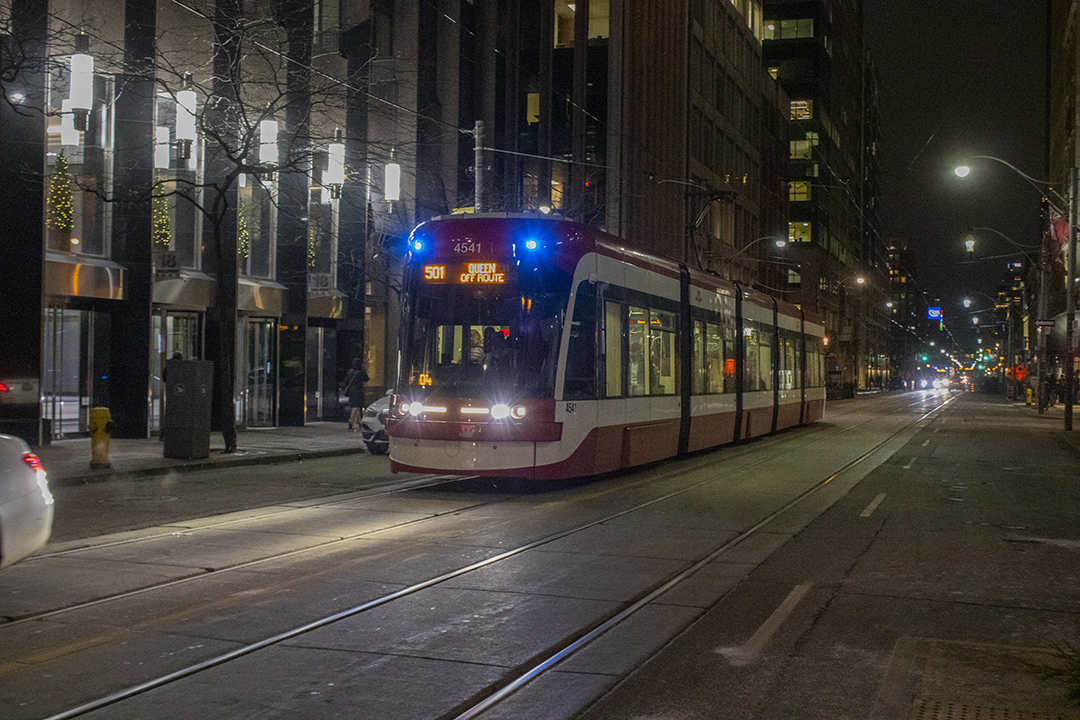Have you ever been late for class or missed an appointment due to delays in TTC service? This reality is common among those who use the TTC.
Unfortunately, long waits and missed buses have become more common in recent months after the TTC temporarily reduced service across 57 surface routes and subway service on the Bloor-Danforth Line 2. Cuts to transit service impact those who need transit the most, including frontline workers and students, and could have long-term negative consequences on the environment, since people who can afford it will probably switch to using their cars.
Toronto Mayor John Tory should immediately reverse TTC cuts, which predominantly affect the most vulnerable in our community. It didn’t need to be this way. Transit expert Steve Munro suggests that the TTC was already running less service than it had scheduled prior to the vaccination mandate coming into effect. The TTC had months to prepare for a labour shortage but did not start a big hiring blitz because of a lack of funding.
With transit ridership below 50 per cent, the TTC has faced major budget shortfalls since March 2020 — and it’s not just a problem in Toronto. As Marco D’Angelo, the president of the Canadian Urban Transit Association, explains, “More than two million people rely on transit every day. But cities won’t be able to keep it running unless Ottawa and the provinces provide more financial support.”
In 2020 and 2021, both federal and provincial governments aided in the delivery of $4.6 billion in emergency transit operation funds, but this funding has run out, and mayors across Canada are warning that without ongoing support, transit agencies might further cut service. These cuts could not only hurt people who rely on transit but also the environment, in our battle against the climate crisis.
Cities are unable to foot the revenue loss alone. The Canadian Urban Transit Association estimates that for every 10 per cent reduction in ridership, “transit systems lose $470 million nationwide.” The TTC is predicting a $561 million shortfall in revenue in 2022 alone.
The TTC is not expected to restore its ‘pre-pandemic’ levels of service until June 2022, which will be too late and will have a prolonged detrimental effect for all Toronto residents. In 2021, the TTC had a $36 million operating surplus, but this was not ‘reinvested’ directly for more service. The more people who ride the TTC, the more funds the TTC will have to improve service, adjust crowding standards, and increase non-rush hour service.
So how can the TTC increase its ridership after the latest lockdown? Some of it depends on the policies of workplaces and universities regarding in-person work and school. But the TTC also needs to implement changes in order to bring back riders.
The TTC has focused on its “Service Plan Reset and Ridership Reacquisition Strategy,” but there are no resources allocated to implement the strategy this year. If we want net zero emissions, the TTC must actually utilize strategies like that, which would increase public transit use, especially bus and streetcar service.
There are also a few ways to attract people back to the system, including handing out masks and hiring more staff to distribute them. Boosting ridership also involves lowering, integrating, and capping fares. Unfortunately, the TTC’s 5-Year Fare Plan, a review of all TTC fare policies and possible plans for transit budgeting, has been delayed three times because funding was not included in the 2022 Toronto City Budget.
The TTC must also reduce fares for those who need public transit the most: low-income residents. The Fair Pass is a poverty reduction strategy that the TTC introduced to alleviate the already vulnerable position that low-income residents within Toronto face. This is evident, as 65 per cent of Fair Pass users rode the TTC in 2020 — during a pandemic that left low-income residents even more vulnerable than usual — compared to 35 per cent of all regular riders. However, the Fair Pass program is not fully funded and will cost around $20 million per year.
To create a more sustainable, equitable, and affordable transit system, the TTC must reduce fares and ensure that there is permanent operational funding in order to lessen the burden of funding on riders. The current budget shortfall is an even larger indication that the TTC needs provincial investment in permanent transit operation funding in order to keep the current system afloat and improve it.
It is time that Mayor Tory and the TTC board work to rebuild our broken transit system so it works for everyone, especially working people. This would mean lowering fares and securing funding to stop service cuts. An integral part of this is further COVID-19 protection, the 5-Year Fare Plan, and a strategy to secure further emergency funding. The TTC must move away from relying on the farebox and move to secure permanent operational funding to maintain safer service levels.
We must all exercise our civic commitments to make our city more livable; we can make our voices heard by speaking at the TTC board meeting on February 10 or joining the rally on February 14. We must demand what we deserve, especially for the most vulnerable within our communities.
Thai Dillon Higashihara is a fourth-year political science and international development studies student at UTSC. He is currently the outreach director of Oxfam UTSC and a member of TTCriders, a Toronto-based transit advocacy organization.


